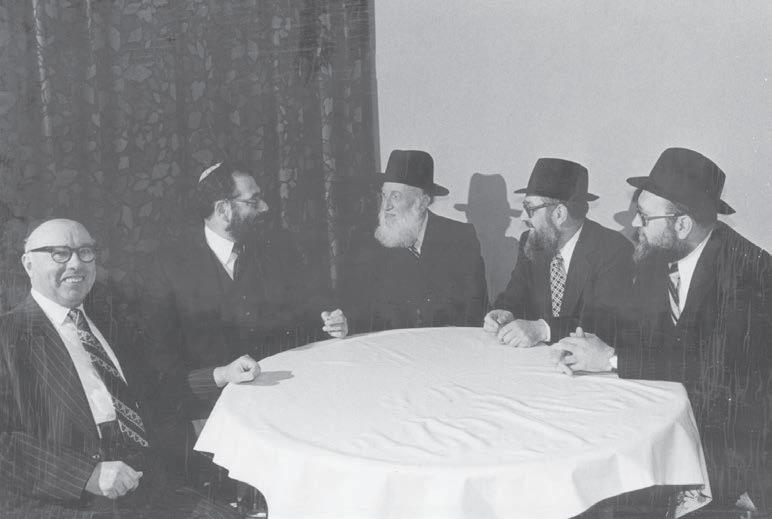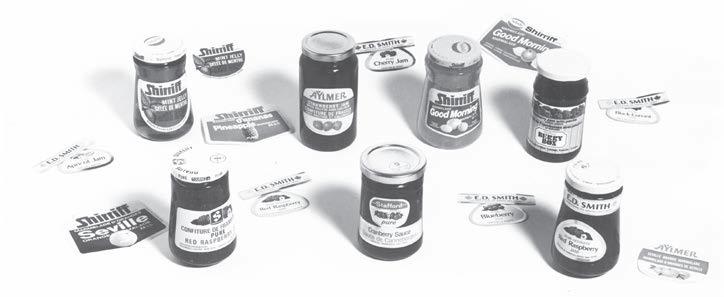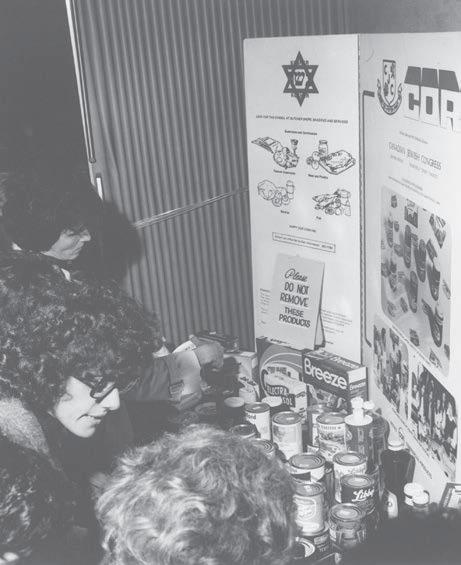
4 minute read
A Brief History of COR
BY SHERYN WEBER
In the 1940s and early 1950s kosher meat supply in Toronto was unregulated and chaotic, a situation that frustrated the local Jewish community. Many other North American cities were experiencing the same state of disorganization of kashrut. Meyer W. Gasner, chairman of Toronto’s Division of Orthodox Synagogues, asked Canadian Jewish Congress (CJC) to help launch an effective and orderly supervisory regime for kosher meat in Toronto.
Advertisement
As stated by Mr Gasner: “Why is the leadership of Congress taking such an active interest in the supervision of kosher meat supplies? The answer is clear and simple – because the religious welfare of the community is every bit as important as the educational, cultural and social welfare of Toronto Jewry.”
In the early 1950s, an Orthodox Division within CJC was established. It was made up of ten synagogue presidents: H. Korolnek, N. Urbach, Louis Zuker, I. Weinberg, C. Weinberg, J. Levine, S. Kurtz, H. Botnik, Saul Sigler, and Meyer Gasner, with the latter serving as chairman. The group met in November 1952 and formally established the Kashruth Committee.
The mandate of the Kashruth Committee would include: a) Consolidation of all existing forms of supervision under the auspices of the Kashruth Committee; and b) the establishment of an intensified public relations program in order to increase awareness and observance of the laws of kashrut
After conducting many meetings and evaluating the kashrut structure of several cities, the Orthodox Division decided to base its new Toronto organization on the model used by Cleveland, a city that had a successful structure in place for several years. In short, both a lay and an halachic committee ran the Cleveland kashrut program.
During the November 1952 meeting, the newly appointed Kashruth Committee of CJC was authorized to certify food products as kosher. In November 1953, the Kashruth Committee met and authorized the chairman to invite rabbis to be on the Vaad Hakashruth.
In 1954, the name “Vaad Hakashruth of the Canadian Jewish Congress of the Central Region” was adopted. The membership consisted of 12 pulpit rabbis. The Rabbinical Council of the Vaad Hakashruth was comprised of: Rabbi G. Felder, Rabbi B. Rosensweig, Rabbi D. Schochet, and Rabbi W. Wurzburger. They had full authority over matters of halacha with respect to kashrut. Upon the recommendation of Rabbi Wurzburger and with the approval of the rabbis, Rabbi Gedalia Felder was appointed chairman.
Mr. Meyer Gasner became chairman of the lay committee and Rabbi Nachman Shemen was engaged to run the department.
In June 1956, the rabbinic body adopted the name, “Council of Orthodox Rabbis” affiliated with CJC. This is the source of the Kashruth Council of Canada’s “COR” logo.
The parties agreed that CJC would undertake the administrative responsibilities while all matters of religious law would be handled by the Rabbinical Vaad Hakashruth (RVH). In 1958, the RVH included Rabbi M. Ochs, Rabbi M. Gorelik, Rabbi B. Hauer, and Rabbi W. Herskowitz.

Prior to the establishment of the RVH, there had been problems with many butchers displaying unregulated signs saying “kosher”. Now, with the establishment of COR, there was one authority in Toronto, instead of a variety of unaffiliated rabbis, shochtim, and wholesalers. These individuals were now united under one banner to serve the common good and to ensure a high standard of kashrut in Toronto. By 1958, there were 17 butcher shops under the supervision of the RVH.
Nevertheless, there was still work to be done in the community to gain the support and trust of consumers in this new kashrut endeavour. One of the most important ways to accomplish this goal was to enlist the support of Jewish housewives. In a 1958 article in the
Canadian Jewish Review, Ben Kayfetz, national director of Congress's Joint Community Relations Committee (and a close friend of Nachman Shemen) wrote: “Affiliation with the kashruth program of the Canadian Jewish Congress is open to all butchers who are prepared to accept the proper standards of kashruth, which in no way affects the price of meat to you. It is the wish of Congress that every Jewish housewife avail herself of the opportunity created to restore the sacredness and dignity which the term ‘kashruth’ represents.....Buy your meat and poultry where the sign of the kashruth committee of the Canadian Jewish Congress is displayed.”
During the early years, COR had a number of successes. Perhaps chief among them was lobbying then Prime Minister John G. Diefenbaker to have Jewish ritual slaughter (shechita) approved by the government of Canada and protected by law.

For many years, Rabbi Gedalia Felder was COR’s chairman of the RVH, while Rabbi Yitzchok Kerzner, was vicechairman, and in 1987, acting chairman of the RVH. Yitz Feldman became lay chairman in 1977 and held that position for many years. Rabbi Mordechai Levin joined COR’s staff in 1984 to assist Rabbi Shemen in the administration of the department.
Meanwhile, in 1976, Canadian Jewish Congress of Toronto was restructured to form the Toronto Jewish Congress, which was restructured again in 1994 to form the Jewish Federation of Greater Toronto and in 2010 became UJA Federation. In July 2000, the Orthodox Division of Federation (COR) was incorporated as a legal, non-profit entity. It became the Kashruth Council of Canada/Le Conseil Cacherout du Canada under the chairmanship of Marvin Sigler.

In 2006, Rabbi Yacov Felder, son of Rabbi Gedalia Felder, took on the position of vice-chairman of the RVH and is currently its acting head. Moshe
Sigler, grandson of Saul Sigler one of the founding lay board members, serves as chairman of the lay board. Having briefly recounted the formation and progress of COR, it is interesting to reflect on the fact that the Kashruth Council of Canada was established under the most trying of circumstances approximately sixty years ago. It has now grown into Canada’s largest kashrut agency, certifying over 120,000 products at approximately 1200 facilities across Canada and beyond. But its present place in the world of kashrut is due to the contribution of countless dedicated people over the years. No one person or group can build an agency such as the Kashruth Council of Canada. It takes an entire Jewish community, working together, to form this type of organization.
In an impassioned appeal to the Jewish community many decades ago, Rabbi Gedalia Felder expressed what kashrut and the work of the Kashruth Council of Canada means: “The Dietary Laws are important among the fundamentals of Judaism. Their purpose is the Sanctification of Life, the attainment of Kedusha, (holiness) for which we emerged from bondage and became a people.....'And ye shall be unto me a Kingdom of Priests and a Holy Nation' (Exodus 19:6), are words which were told to all the children of Israel. This concept of being a holy people was an important factor in the preservation of our people in the past. It safeguarded us against the onslaught of time. It is in more than one respect an irreplaceable instrument for maintaining Jewish identity in the present.”
This timeless message holds as true today as it did 70 years ago. g








